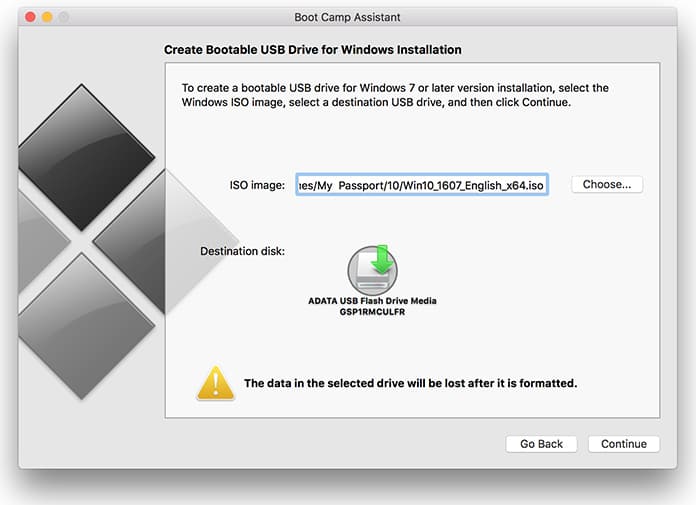
How To Make A Bootable Windows 10 Usb For Mac On Window
This will make your USB drive bootable in Windows 10 (and older versions). Best audio interface for mac. Copying files from a DVD to bootable USB using CMD: Let us assume that the USB drive is the G: drive and the DVD drive. Alternatively, in case of the need to perform an upgrade to a PC that is already running Windows 7 SP1, Windows 8.1 Update, or technical previews of Windows 10, simply accessing the flash drive within Windows and running setup.exe should begin the upgrade process.
I'm trying to get my Mac to boot from a USB flash drive. I know the drive works and is bootable, because it works with my friend's Windows PC. Specifically, I was running Windows 7 on my Mac to create the bootable disk, which has Windows Defender Offline on it. I have had the same issue trying to use the Ultimate Boot CD on a USB, various Live USBs for Linux, etc.
So, what do I have to do to get my Mac to recognize and boot from another OS on a USB flash drive? Or maybe a better question, if there isn't a simple answer, would be what does Bootcamp do to allow booting from a Windows install DVD or to allow Windows, once installed, to boot? EDIT: I was able to sort of get results using the bless command in Terminal.
Specifically, I used sudo bless -mount '/Volumes/WDO_Media32/' -legacy -setBoot -nextonly and then did a restart. Boot was slower, but then I was presented with the normal log-in screen. The log in screen, though, was much slower than usual, as if something else was happening in the background. So, I seem to be effecting something with that command, but I still can't boot from my Windows bootable USB drive. Boot Camp has to emulate a BIOS system, as Windows requires this to run. Apple uses something called the bless tool in order to instruct EFI (which Macs are based on) to activate this BIOS system.
However, if I recall correctly, emulation of BIOS is not supported on Mac for any device that is not attached via a SATA connection (ie. Internal drive, DVD drive).
So, I believe that you cannot boot from your USB key. If you want, you could install an alternative bootloader on your Mac that would allow you to do this. I don't think Windows 7 requires a BIOS to run. I'm pretty sure it works with an EFI system as well. In any case, the boot drive I'm trying to make includes an EFI folder in the root directory. Seems like it should work with EFI. I used to use rEFIt when I had a triple-boot setup with Mac OS, Ubuntu, and Windows XP.

Installing Lion seems to have disabled it, and I was afraid to enable it again in case it's not compatible. I'll do some research and see it if still works with Lion, despite not being updated recently. – Jul 29 '12 at 21:25 •.
You can in fact boot Windows from a USB drive on a Mac. I've done this recently with the Windows 10 Technical Preview, but the software I used should work with Windows 7+, but it does have a disclaimer that says Windows 7 does not support USB 3.0, so if you're trying this on a newer Mac, you'd have to use Windows 8 or higher. I'm booting Windows 10 off of an external USB to SATA hard drive dock. It takes a while for Windows to boot, but it runs okay once it's started. I imagine it'd be much faster if I was running USB 3.0.
I needed another Windows computer to run the utility called 'WinToUSB' here is a link to their site: You will need a Windows installer disk or ISO image to create the bootable image. Do NOT attempt to create or format any of your Mac partitions from within Windows because there is a very high chance you will lose some/all of your Mac data. I've verified this. The only problem I had doing it is that the destination HDD had to be partitioned in a very specific way: GPT partitioning,with EFI boot and System partitions. You'll know if you run into the same problem because WinToUSB won't show a radio box for the System partition when it asks you for the destination for the clone. (I chose the third option, to clone an existing VM to a real HDD so I could boot natively into Windows, rather than run under a VM manager.